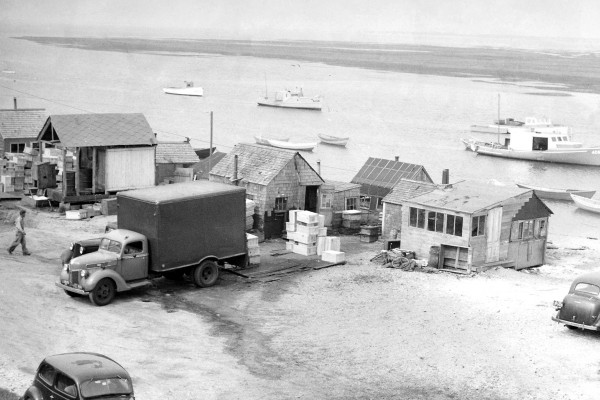
A view of the shanties in 1945, the pier was built a year later. AP Photo courtesy of Susan Mulgrew
Lisa Cavanaugh
The “tiny house” phenomenon has been all the rage for several years, but one type of mini-structure is fading into Cape Cod history: the fish shanty.
You can still see a few in places like Harwich’s Wychmere Harbor, where a line of small wooden storage sheds for lobster pots fringe the parking lot, capped by a slightly larger wooden building at water’s edge that houses the town’s shellfish upweller. But shorelines or piers crammed full with bait shanties are now only visible in old photos and artistic renderings.
Used for centuries by working fishermen, the typical fish shanty was a small wooden building that allowed people to cut bait and work on hooks, lines and tub coils protected a bit from the elements, as well as offering a convenient, safe place to store gear. They also fostered a boisterous and purposeful camaraderie among fishermen.
In Chatham, fish shanties originally popped up in a cluster at the harbor. Once the town constructed the fish pier in 1946, a more uniform set of structures was erected, running in a double line down to the water south of the fish market. Municipally owned, they were rented to local fishermen, each of whom outfitted a cozy shed for comfort and efficiency.
Fisherman and artisan Nick Nickerson, whose family owned the fish market at the pier for many years, recalls the shanties well.
“There was a central baiting storage, a freezer, for whomever wanted it at the Wharfinger’s office,” he says. “We all did trawl gear in those days, and you had to chop your own bait most of the time. When everybody’s going fishing tomorrow, everybody’s baiting.”
Nickerson remembers how local kids helped out by chopping bait at the shanties. “They were just young kids chopping herring for their fathers and other fishermen.”
Chatham native Bob Stello wasn’t yet in junior high in 1959 when he first started cutting bait at the shanties.
“My dad was a fisherman and a boat builder,” he says, “and we lived on Seaview Street, so I would just walk over to the pier and cut herring for the guys.” Stello would get up at 4 am and cut until school started, then come back after classes or sports ended and keep baiting until late at night.
“I’d work every free minute I had, it was just the way you helped out,” he says. “Before they put the freezer in at the pier, my mother would drive me to Red River Beach in Harwich, where there was a big freezer. We’d load up 50-pound cans of herring, mackerel, and sea clams, and then head back to Chatham so I could start cutting.
“I was driven to work hard,” he remembers. “You had so many pounds of fish to cut and the more you did the more you got paid. We used machetes, and there were some injuries, you could freeze your rear off in the winter, but it was a lot of fun. I had my own shanty and I took real good care of it, put in paneling and everything.”
In addition to cutting bait, Stello worked on unsnarling and re-rigging trawl gear, boxing fish at the fish house, and helping fishermen unload when they came back in with their day’s catch. “I worked my way through college at the pier. There was always so much going on.”
Stello taught earth science at local schools and now runs a construction company in Chatham. He remembers plenty of all-nighters spent in his shanty.
“Tourists from all over, even Europe and Australia, would come by to see what we were doing, and ask questions. I remember a Japanese guy who gave me my first sushi. He showed me the parts of the fish to eat raw. It was fascinating.”
Ted Ligenza, who shared Ed Tucker’s original bait shanty with Captain Mike Anderson, is also nostalgic about his time using a shanty at Chatham fish pier.
“I had a woodstove, so it was nice! I loved having that,” he says. “I used mine to shuck scallops. Back then bay scalloping was a big deal, everybody would go bay scalloping. So you’d have your own shanty down here and shuck’em inside.”
“It was a huge social thing,” says Anderson. “Early in the morning everybody was there. People baiting their gear, telling tales, getting into fist fights. It was terrific.
“It was a weird, wonderful community, a regular circus,” he says.
The town eventually removed the shanties in the very early 1980s, in response to the changing nature of the fishing industry and to make room for more parking.
“I never knew why it happened,” says Ligenza. “There was never any discussion on it, they just took them down.”
Today, maneuvering through the busy lower parking lot of the pier, it’s hard to imagine how much took place at that spot. But the older generation who spent days and nights cutting, baiting, rigging, jostling and laughing remember it all.
“I had a really rewarding childhood there,” says Stello. “I learned so much from those guys.”
